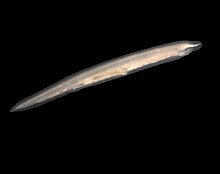| Lancelet | |
|---|---|

| |
| Branchiostoma lanceolatum | |
| Scientific classification | |
| Domain: | Eukaryota |
| Kingdom: | Animalia |
| Clade: | Nephrozoa |
| Superphylum: | Deuterostomia |
| Phylum: | Chordata |
| Subphylum: | Cephalochordata Haeckel, 1866[2] |
| Class: | Leptocardii Müller, 1845[1] |
| Genera | |
| |
| Synonyms | |
The lancelets (/ˈlænslɪts, ˈlɑːn-/ LA(H)N-slits), also known as amphioxi (sg.: amphioxus /ˌæmfiˈɒksəs/ AM-fee-OK-səs), consist of 32 described species of "fish-like" benthic filter feeding chordates[9] in the subphylum Cephalochordata, class Leptocardii, and family Branchiostomatidae.[10]
Lancelets diverged from other chordates during or prior to the Cambrian period. A number of fossil chordates have been suggested to be closely related to lancelets, including Pikaia and Cathaymyrus from the Cambrian and Palaeobranchiostoma from the Permian, but their close relationship to lancelets has been doubted by other authors.[11][12] Molecular clock analysis suggests that modern lancelets probably diversified much more recently, during the Cretaceous or Cenozoic.[13][14]
Zoologists are interested in them because they provide evolutionary insight into the origins of vertebrates. Lancelets contain many organs and organ systems that are homologous to those of modern fish, but in a more primitive form. Therefore, they provide a number of examples of possible evolutionary exaptation. For example, the gill-slits of lancelets are used for feeding only, and not for respiration. The circulatory system carries food throughout their body, but does not have red blood cells or hemoglobin for transporting oxygen.
Lancelet genomes hold clues about the early evolution of vertebrates: by comparing genes from lancelets with the same genes in vertebrates, changes in gene expression, function and number as vertebrates evolved can be discovered.[15][16] The genome of a few species in the genus Branchiostoma have been sequenced: B. floridae,[17] B. belcheri,[18] and B. lanceolatum.[19]
In Asia, lancelets are harvested commercially as food for humans. In Japan, amphioxus (B. belcheri) has been listed in the registry of "Endangered Animals of Japanese Marine and Fresh Water Organisms".[20]
- ^ Cite error: The named reference
Müller1845was invoked but never defined (see the help page). - ^ Nielsen, C. (July 2012). "The authorship of higher chordate taxa". Zoologica Scripta. 41 (4): 435–436. doi:10.1111/j.1463-6409.2012.00536.x. S2CID 83266247.
- ^ a b Cite error: The named reference
Bonaparte1846was invoked but never defined (see the help page). - ^ Cite error: The named reference
Fowler1965was invoked but never defined (see the help page). - ^ Cite error: The named reference
Fowler1947was invoked but never defined (see the help page). - ^ Anonymous (1842). Synopsis of the Contents of the British Museum. Forty-fourth Edition. Vol. 44th Ed. British Museum Catalogue: G. Woodfall and son. p. 308.
- ^ Whitley, Gilbert P. (1932). "The lancelets and lampreys of Australia". Australian Zoologist. 7: 256–264.
- ^ Hubbs, Carl L. (1922). "A list of the lancelets of the world with diagnoses of five new species of Branchiostoma". Occasional Papers of the Museum of Zoology, University of Michigan. 105: 1–16.
- ^ Poss, Stuart G.; Boschung, Herbert T. (1996-01-01). "Lancelets (cephalochordata: Branchiostomattdae): How Many Species Are Valid?". Israel Journal of Zoology. 42 (sup1): S13–S66. doi:10.1080/00212210.1996.10688872 (inactive 1 November 2024). ISSN 0021-2210.
{{cite journal}}: CS1 maint: DOI inactive as of November 2024 (link) - ^ Freeborn, Michelle (2015-01-01). Roberts, Clive Douglas; Stewart, Andrew L.; Struthers, Carl D. (eds.). The fishes of New Zealand. Vol. Two. Te Papa Press. p. 6. ISBN 978-0-9941041-6-8.
- ^ Briggs, Derek E.G.; Kear, Amanda J. (1993). "Decay of Branchiostoma: implications for soft-tissue preservation in conodonts and other primitive chordates". Lethaia. 26 (4): 275–287. Bibcode:1993Letha..26..275B. doi:10.1111/j.1502-3931.1993.tb01532.x. ISSN 0024-1164.
- ^ Nanglu, Karma; Cole, Selina R.; Wright, David F.; Souto, Camilla (February 2023). "Worms and gills, plates and spines: the evolutionary origins and incredible disparity of deuterostomes revealed by fossils, genes, and development". Biological Reviews. 98 (1): 316–351. doi:10.1111/brv.12908. ISSN 1464-7931. PMID 36257784. S2CID 252995259.
- ^ Zhang, Qi-Lin; Zhang, Guan-Ling; Yuan, Ming-Long; Dong, Zhi-Xiang; Li, Hong-Wei; Guo, Jun; Wang, Feng; Deng, Xian-Yu; Chen, Jun-Yuan; Lin, Lian-Bing (2018-12-18). "A Phylogenomic Framework and Divergence History of Cephalochordata Amphioxus". Frontiers in Physiology. 9: 1833. doi:10.3389/fphys.2018.01833. ISSN 1664-042X. PMC 6305399. PMID 30618839.
- ^ Cite error: The named reference
Igawa2017was invoked but never defined (see the help page). - ^ Worm-like Marine Animal Providing Fresh Clues About Human Evolution Newswise, Retrieved on July 8, 2008.
- ^ Holland, PWH (1992). "An amphioxus homeobox gene: sequence conservation, spatial expression during development and insights into vertebrate evolution". Development. 116 (2): 653–661. doi:10.1016/0168-9525(93)90180-p. ISSN 0168-9525. S2CID 7298022.
- ^ Rokhsar, Daniel S.; Satoh, Nori; Holland, Peter W. H.; Holland, Linda Z.; Fujiyama, Asao; Bronner-Fraser, Marianne; Toyoda, Atsushi; Shin-I, Tadasu; Schmutz, Jeremy (2008). "The amphioxus genome and the evolution of the chordate karyotype". Nature. 453 (7198): 1064–1071. Bibcode:2008Natur.453.1064P. doi:10.1038/nature06967. ISSN 1476-4687. PMID 18563158. S2CID 4418548.
- ^ Xu, Anlong; Chen, Shangwu; Dong, Meiling; Wu, Fenfang; Fu, Yonggui; Yuan, Shaochun; You, Leiming; Zhou, Sisi; Qiujin Zhang (2014-12-19). "Decelerated genome evolution in modern vertebrates revealed by analysis of multiple lancelet genomes". Nature Communications. 5: 5896. Bibcode:2014NatCo...5.5896H. doi:10.1038/ncomms6896. ISSN 2041-1723. PMC 4284660. PMID 25523484.
- ^ Marlétaz, Ferdinand; Firbas, Panos N.; Maeso, Ignacio; Tena, Juan J.; Bogdanovic, Ozren; Perry, Malcolm; Wyatt, Christopher D. R.; de la Calle-Mustienes, Elisa; Bertrand, Stephanie; Burguera, Demian; Acemel, Rafael D. (December 2018). "Amphioxus functional genomics and the origins of vertebrate gene regulation". Nature. 564 (7734): 64–70. Bibcode:2018Natur.564...64M. doi:10.1038/s41586-018-0734-6. ISSN 1476-4687. PMC 6292497. PMID 30464347.
- ^ Tomiyama, Minoru; Azuma, Nobuyuki; Kubokawa, Kaoru (1998). "A New Population of the Amphioxus (Branchiostoma belcheri) in the Enshu-Nada Sea in Japan". Zoological Science. 15 (5): 799–803. doi:10.2108/zsj.15.799. ISSN 0289-0003. S2CID 85834803.